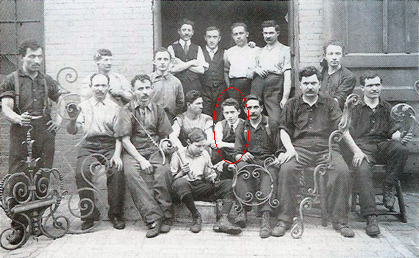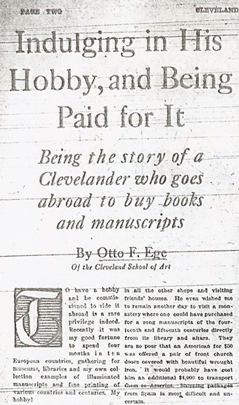Introducing Otto Ege

Workers at the Yellin Ironworks, 1913. Jack Andrews, "Samuel Yellin, Metalworker" (SkipJack Press, 1992).
Otto Frederick Ege (“EGG-ee”) was a longtime resident of Cleveland, Ohio, and held the posts of Professor of Art History and Dean at the Cleveland Institute of Art. He was born in Reading, Pennsylvania in 1888, graduated from Reading High School in 1907, and went on to study design at the Philadelphia Museum School of Art (known today as the University of the Arts) and art education at New York University. As an apprentice to master ironworker Samuel Yellin, Ege helped create some of the ironwork for St. Thomas Cathedral in New York City and for the Daughters of the American Revolution Building in Washington, D.C. In 1920, at the age of 32, he moved to Cleveland, and spent the next 31 years (the rest of his life) as a resident of that city and a member of the faculty of the Cleveland Institute of Art; he served as the CIA’s Dean from 1946 until his death in 1951. [1]
At the time of his death he was remembered by friends and students from Reading, Philadelphia, and Cleveland as a consistent promoter of the book arts to generations of students, as a congenial teacher and respected colleague, and as a man always ready to share his personal collection of medieval and modern books with the public. An extensive microfilm memorial consisting of newspaper clippings and exhibit mementos remains the chief archival source of biographical information about his public life. [2]

Early publicity of Ege's activities. (The Plain Dealer, January 26, 1923.)
Ege’s professional career was devoted to improving the teaching of art, and he cultivated a reputation in northern Ohio as an assertive advocate for fine arts pedagogy in the general public. It is clear that he implicitly considered his role as a teacher to include the mentoring of future teachers: soon after arriving in Cleveland in 1920 he headed a reorganization of the Department of Teacher Training at the Cleveland Institute of Art, “striving for higher standards in the teaching of art, in addition to better art training for teaching.” [3]
Alongside his new appointment as a department chair, Ege also served as an instructor of Lettering, Layout and Typography at the Institute. In these varied capacities he instituted innovations such as summer schools, night schools, and—very unusual at the time—classes especially designed for children; in the 1930s he expanded his energies to include the teaching of courses in art history at the Western Reserve University (now Case Western Reserve University). He was also an active member for many years of advocacy and resource groups such as the National Education Association, the Society for the Study of Aesthetics, the Western Arts Association, the Eastern Arts Association, and the American Institute of Graphic Arts. [4]
While his training in aesthetics and design was quite strong, it should be noted that Ege did not have any extensive academic training in bibliography, textual criticism, or librarianship. What he did have, however, was enduring enthusiasm, commitment, charisma, and aptitude, and through continuing self-education he became a regional authority on medieval and early modern book arts. He gave lectures in a variety of settings throughout Ohio and western New York and Pennsylvania, and this eagerness and willingness led to his enviable service, in 1923, ’25, and ’28, as a tour guide and traveling buyer for several northern Ohio libraries and museums. He had already explored Europe twice while a student in Philadelphia before World War I, and he made his earliest acquisitions of medieval texts in 1911, but in the mid- to late-1920s he was an academic professional commissioned to conduct tours and purchase examples of illuminated manuscripts and fine printed specimens; he was able to attend events like the 1928 International Art Congress in Prague, and on one occasion (probably in 1928) he spent four months shuttling between ten European countries, experiences he later wrote about. [5]
While purchasing artifacts in this contractual role he was also able to gain tremendous practical awareness of the rare book trade and to use his own modest resources to build a personal collection of leaves and codices—and this was, as his income dictated, a collection consisting largely of fragmentary copies and works which had been damaged in some way. [6] Ironically, because of these financial limitations it is likely that by 1930 Ege possessed one of the largest personal collections of medieval manuscript fragments in North America.
Click "Next" below to continue to page 2.
_________________________
[1] This introduction by Fred Porcheddu appeared as part of “Otto F. Ege: Teacher, Collector, and Biblioclast” in Art Documentation 26.1 (2007). It is reprinted here by permission of the Art Libraries Society of North America.
[2] Dean Otto F. Ege: A Microfilm Memorial, Arranged by his School Mates and Friends of Reading, PA (The Gund Library, Cleveland Institute of Art, c.1952), I-VI. See also Peter Hastings Falk, ed., Who Was Who in American Art (Madison, CT: Sound View P, 1985), 183, and Nancy Coe Wixom, Cleveland Institute of Art: The First Hundred Years, 1882-1982 (Cleveland: Cleveland Institute of Art, 1983). Ege was eulogized in Art Education 5.1 (1952): 3, and by his colleague Henry C. Pitz in College Art Journal 11.1 (Autumn, 1951): 41-42.
[3] Dean Otto F. Ege III:3.
[4] Falk 183.
[5] Otto F. Ege, “Indulging in his Hobby and Being Paid for It: Being the Story of a Clevelander who Goes Abroad to Buy Books and Manuscripts,” Cleveland Plain Dealer, January 26, 1923. It should be emphasized that these statements come from Ege himself, and that the details of his European trips (as well as of his book- and leaf-buying in general) have not yet been ascertained.
[6] J. A. Wadowick, “Leaves a Legacy of Bible Leaves,” Cleveland Plain Dealer, July 20, 1951.